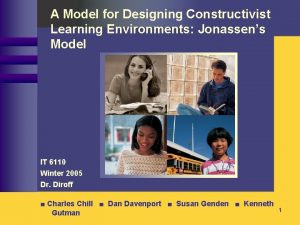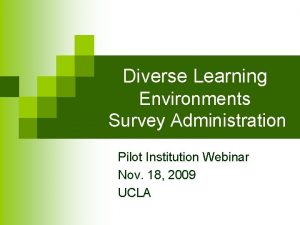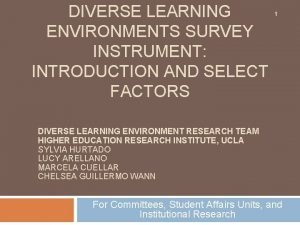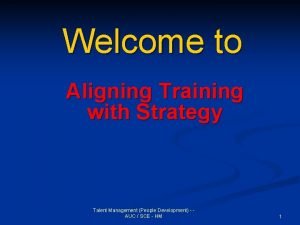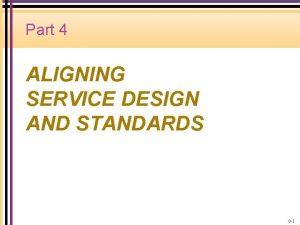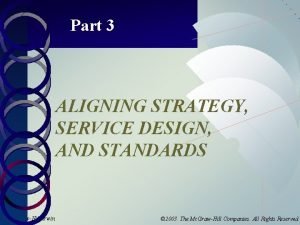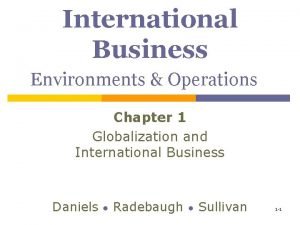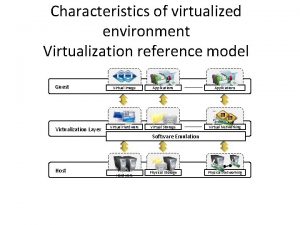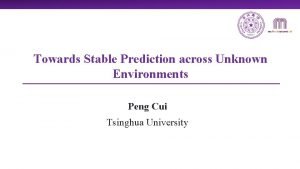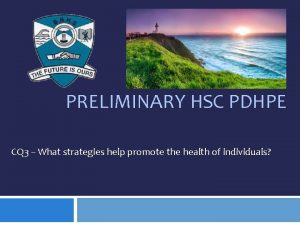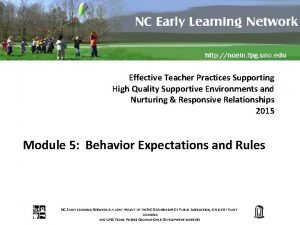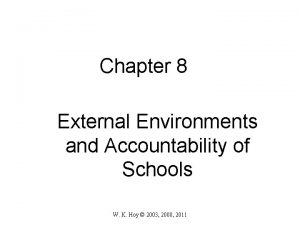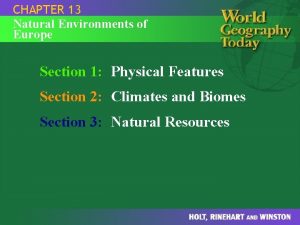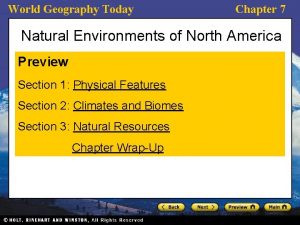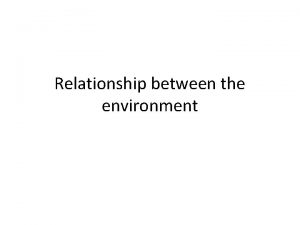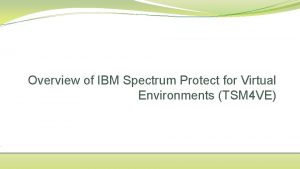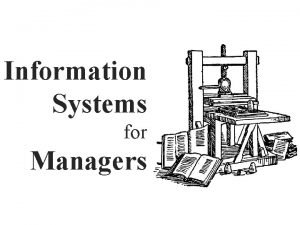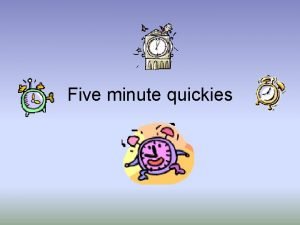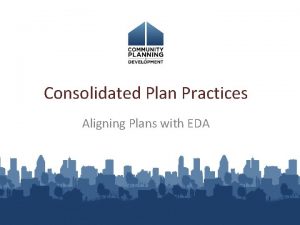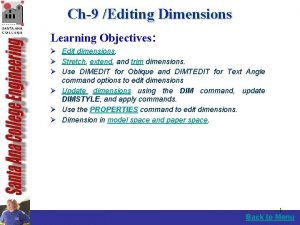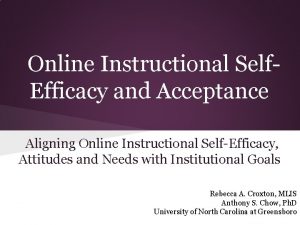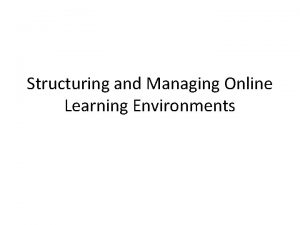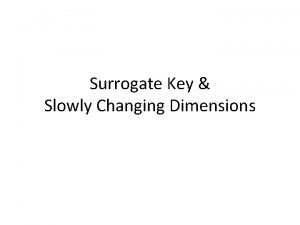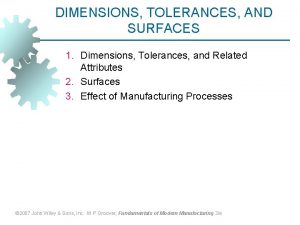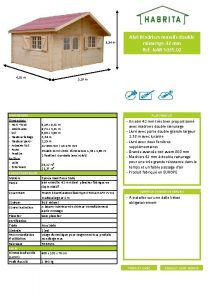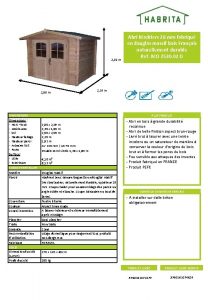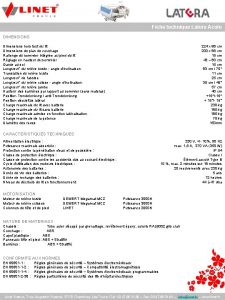Aligning the Key Dimensions of Online Learning Environments






























- Slides: 30

Aligning the Key Dimensions of Online Learning Environments to Enable Student Success Dr Darien Rossiter and Janet Baker Third international conference e-Learning and distance learning

Australian Higher Education Key Features Government Led Sector Reform improve completion rates – 2012 - 36. 8% of 25 -40 year olds with bachelor or higher degree (DIIRSTE) increase in participation from low SES & indigenous students Quality – establish TEQSA, Higher Education Quality Standards Increase in diversity of student population - led to increase in need for student support Growth in online education (18. 6% 2008 – 2013) (Ibis World)

Australian Higher Education Sector 9, 00% 8, 00% Online Enrolment Increase 2010 -2011 (%) 8, 30% Commencing students All students 7, 00% 6, 00% 4, 70% 5, 00% 4, 00% 2, 90% 3, 00% 1, 70% 2, 00% 1, 20% 1, 00% 0, 40% 0, 00% Internal External (online) Multi-modal (online components)

Australian Government Quality Agenda Tertiary Education Quality & Standards Agency: Regulatory “watchdog” Higher Education Standards Panel: Standards Framework Provider Standards, Qualification Standards, Teaching and Learning Standards, Information Standards and Research Standards • Australian Qualifications Framework Council

Diversity of the Online Student Cohort Professionals wishing to upgrade skills; Career changers who take up study for entry into a different profession; Mature-aged students who take up units for personal interest; International students of a language background other than English (LBOTE); Students with health issues or special needs Students with carer responsibilities Traditional school leavers Non-traditional students and ‘At-risk’ students

Reasons for Studying Online 5% 32% 54% work commitments family or personal can't get to campus prefer to study this way catch up on study elsewhere 36% 41% Source: OUA Student Survey 2011

Student Feedback Best and worst things about being an online learner Worst Best Structure Friendships Lack of disruptions Great feedback Stimulating/motivating Degree from a recognised university Confusion/overwhelmed Cyberbullying Online degree not as credible Having to wait for feedback Having to give peer feedback Technology issues Feeling ignored/neglected Online lectures Reduced support OUA, Griffith University, University of South Australia, Curtin University Study 2011 -2012

What is Student Success and Who Determines it? Government The Student Employers University Senior Managers Academic Staff Industry

What is Student Success? Measures of Success Completion Student retention and attrition Progression Engagement Grades and Assessment Student Satisfaction

Grades and Assessment Students feedback on the influence of grades Well, for someone who was a C grade student in school I’ve got five passes, two credits and a distinction … I never, I never considered ever getting a distinction. . . (OUA Interview) Well, I guess really the most exciting thing for me has been my distinction in every subject, getting quite good results really in the end, I think really that would be it. (OUA Interview) My positives, you know I just, I think really I was daunted, halfway in you know, I sort of realised, “I can do this”, with my results I got two distinctions with a credit. (UOW Interview) University of Wollongong /OUA Study on Student Engagement 2012

Enabling Student Success Institutional strategies for engagement and motivation Effective student support and interventions

What is Student Engagement? Student engagement is concerned with the interaction between the time, effort and other relevant resources invested by both students and their institutions intended to optimise the student experience and enhance the learning outcomes and development of students and the performance, and reputation of the institution. (Trowler, 2010)

Effective Student Engagement Data from the AUSSE surveys tell us: - Engagement with the learning community is closely linked with student satisfaction and success Student engagement in educationally purposeful activities is positively related to academic outcomes. (Kuh et al. , 2008).

Is Online Learning a Barrier to Effective Engagement? AUSSE Briefing (August 2008) indicates that online learners are not necessarily less engaged with their learning and their institution than the on-campus students Building student identity & sense of belonging – decrease alienation – a stranger in a foreign land (Mann, 2001)

Dimensions of Online Learning Course design and development Student support Staff professional development Learning technologies

Course Design and Development Personalisation Adaptive Learning Authentic Learning Collaborative Learning Supported Learning

Learning, Teaching and Assessment Model OUA Model

Student Support Academic study skills Counselling Preparatory and language assistance units Services for students with disabilities and special needs Online resources Social support Careers advice

Value of Support Mechanisms Support is a condition that promotes student retention. Research points to several types of support that promote retention, in particular academic and social support. (Tinto, 2009). The most important criterion for staying in college is the student’s social support network. (Skahill, 2002/2003) For non-traditional students - importance of: validation, when faculty, students, friends, parents and spouses made an effort to acknowledge these students and what they were trying to achieve. (Rendon, 1998) compensatory effect of student engagement for students who are academically unprepared or first in their families to go to college. (Kuh et al. , 2008)

Student Engagement Lifecycle Career Advice and Information Thinking about studying – browsing the web or talking to Student Advisors Counselling services and Academic support and Student Success Hub End of the Study Period – exams and final assignment preparation Enrolling – preparation for the start of the Study Period Middle of the Study Period – feeling the pressure Start of the Study Period – learning what to do Week 3 Census Date – making the commitment PREP units, Counselling and Disability Services Proactive intervention emails OUA Model

Staff Professional Development Formal Accredited • Graduate Certificate / Masters in Tertiary Education • Short Courses and Modules e. g. Formal Unaccredited Self-help Online Resources • Engaging Learners in Online Discussion • Foundations in Learning and Teaching • Personalisation and Student Learning • Using Adaptive Technologies • Designing Learning for the Online Environment • Just-in-time, Bite–sized Resources on Specific Topics e. g. • e-publication tools to enhance student content • Using social media for collaboration • Packaging content outside the LMS • Using technology for Peer Review • Asynchronous collaboration using wikis • Sourcing Open Educational Content • Accessibility

Learning Technologies Framework • Learning Management Systems (and beyond) • Mobile Technologies • Telepresence/ Simulation • Web 2. 0 • Analytics and Assessment Tools

Quality Online Learning Environment Aligning all components for student success • Student support • Staff professional development • Learning technologies • Framework for course design

Importance of Alignment “All components in the system address the same agenda and support each other. The students are ‘entrapped’ in this web of consistency, optimising the likelihood that they will engage the appropriate learning activities. ” (Biggs, 2012)

Data Analytics Potential Data sources • Demographic & geographic • Survey and e. DM • Study load • Academic background • Student service usage (study skills, student coaching) • Academic performance model, segmentation, intervention • LMS usage (eg. GA & analytics tools in PREP) • Interactions with other students (discussion forum)

Data Analytics ? Potential Data sources l u f e s u t s o m s i a t a d t a h W • Demographic & geographic • Survey and e. DM • Study load • Academic background • Student service usage (study skills, student coaching) • Academic performance model, segmentation, intervention • LMS usage (eg. GA & analytics tools in PREP) • Interactions with other students (discussion forum)

What is Learning Analytics? “Learning analytics (LA) is the measurement, collection, analysis and reporting of data about learners and their contexts, for purposes of understanding and optimising learning and the environment in which it occurs. Learning analytics are largely concerned with improving learner success. ” SOLAR, 2011, Open Learning Analytics: An Integrated and Modularized Platform

How Can Learning Analytics Support Student Success? Real time information to student and teacher on engagement and interactions Insights that are meaningful and actionable “Nudge analytics” – timely interventions to keep students moving in the right direction Improve course design Predictive modeling

To Conclude. . . Student success does not arise by chance. It is the result of an intentional, structured, and proactive set of strategies that are coherent and systematic in nature and carefully aligned to the same goal. (Tinto, 2009)

Thank You Questions
 Model-based reflex agents examples
Model-based reflex agents examples Designing constructivist learning environments
Designing constructivist learning environments Diverse learning environments survey
Diverse learning environments survey Diverse learning environments survey
Diverse learning environments survey Aligning training with strategy
Aligning training with strategy Service design and standards gap
Service design and standards gap Aligning hr strategy with business strategy
Aligning hr strategy with business strategy Whmis 1988 symbols vs 2015
Whmis 1988 symbols vs 2015 Aligning brand and culture
Aligning brand and culture Aligning service design and standards
Aligning service design and standards Cuadro comparativo e-learning m-learning b-learning
Cuadro comparativo e-learning m-learning b-learning What are key activities in a business model
What are key activities in a business model Business model canvas tripadvisor
Business model canvas tripadvisor The widening set of interdependent relationships
The widening set of interdependent relationships Characteristics of virtualization
Characteristics of virtualization Components of the business environment
Components of the business environment Chapter 13 natural environments of europe
Chapter 13 natural environments of europe Stable prediction across unknown environments
Stable prediction across unknown environments Psychologically informed environments
Psychologically informed environments Psychologically informed environments
Psychologically informed environments Creating supportive environments smoking
Creating supportive environments smoking High quality supportive environments
High quality supportive environments Administering task environment
Administering task environment Chapter 13 natural environments of europe
Chapter 13 natural environments of europe Chapter 7 natural environments of north america
Chapter 7 natural environments of north america Why are cold environments under threat
Why are cold environments under threat Relationship between micro and market environment
Relationship between micro and market environment Include.vmsnapshotattempts
Include.vmsnapshotattempts The actors and forces outside marketing
The actors and forces outside marketing Implations
Implations Story openers
Story openers

